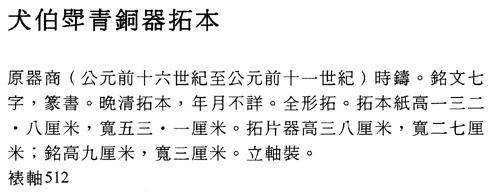 |
|
|
 |
|
|
Rubbings from the
Inscribed Bronze Wine Vessel �Quan Bo� Jia Shang
dynasty (ca. 1600�ca. 1100 b.c.e.),
undated Hanging
scroll, ink rubbed on paper; 132.8 x 53.1 cm; height of rubbing of vessel:
approx. 38.0 x 27.0 cm; height of rubbing of inscription: approx. 9.0 x 3.0 cm Date
of rubbing not given; Qing dynasty (1644�1911), late 19th�early 20th century Inventory number: Biaozhou 512 Over
the course of many decades, the National Library of China has assembled a
collection of more than 3,000 rubbings taken from inscribed bronze vessels and
instruments.� Some 2,000 of these
rubbings are from vessels and instruments of the Shang, Zhou, and Warring
States periods.� A significant
proportion are so-called quanxing ta (full-figured rubbings) of
bronze vessels.� Great skill is required
for making these kinds of rubbings in which proper gradations of dark and light
ink bring out the vessel's three-dimensional aspects. This
full-figured rubbing was taken from a late Shang bronze vessel known from its
inscription as the "Quan Bo" jia, a tripod type of drinking vessel that
also functioned as a ritual vessel used for storing and carrying wine.� This type of vessel, produced between the
late Shang and early Zhou periods, was consciously designed in a mannered
way.� A single- or two-character
inscription�probably the name of an ancestor or a clan�on the inner surface of jia
is typical of Shang ritual bronzes. Jin wen (bronze inscriptions) are crucial
to dating a given object, determining the identity of its commissioner, and
establishing its function. |
 |